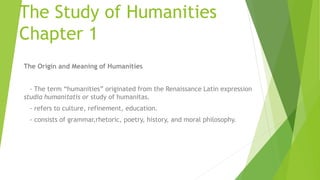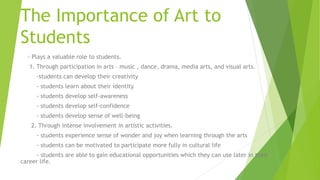The document discusses the study of humanities, specifically focusing on the meaning and importance of art. It covers the following key points:
- The term "humanities" originated from the Renaissance meaning the study of culture, refinement, and education. Art is considered a subject under humanities.
- Art benefits and satisfies humans both creatively and practically. It allows self-expression and plays a valuable role in student development.
- Art appreciation involves interpretation and enjoyment of artworks. Art history examines artistic works in their social and historical contexts.
- Art is assumed to be universal, a reflection of culture rather than nature, and an expression of the human mind and experience.
- The functions of












